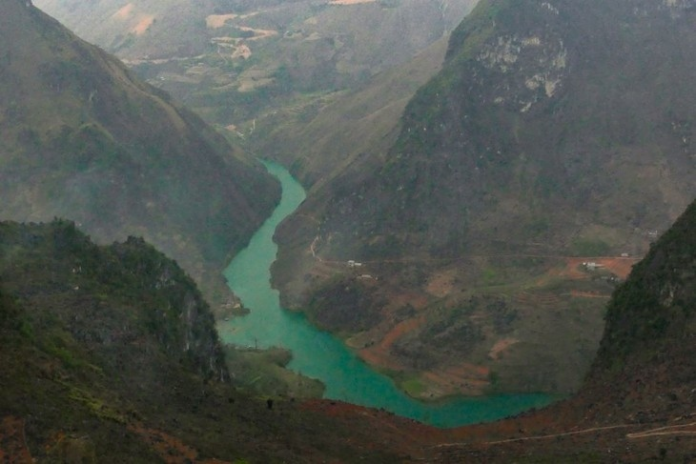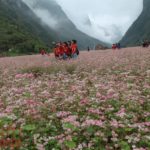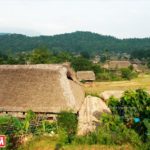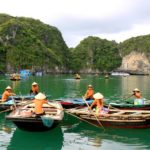The Nho Que River, a 200-km-long waterway, originates in China’s Yunnan province and flows through Vietnam’s Ha Giang province for the final 50 km of its journey. Entering Vietnam at Lung Cu commune in Dong Van district, the river carves its way through the stunning Tu San canyon before bending towards Meo Vac district and the renowned Ma Pi Leng pass, a popular tourist attraction.
Viewed from above, the Nho Que River is a sight to behold. It appears as a shimmering turquoise thread hanging against the rugged mountains and lush forests of the Ma Pi Leng pass. Despite being surrounded by imposing mountains, the river exudes a sense of calm and tranquility.
“I was in awe as I gazed upon the river from above,” shared Pham Duy Nhuan, a tourist from Ninh Binh province. “The turquoise color was even more breathtaking than I had imagined. When I descended to the river, I was thrilled by its beauty and grandeur. The way the sunlight illuminates the ravine and reflects on the river creates a truly picturesque scene.”
Local folklore tells a tale of how the Nho Que River came to be. In the story, the river once flowed on only one side of the mountain, leaving the other side dry and barren. The River Genie, in a request to the Mountain Genie to allow the water to flow to the dry land, was ignored. This prompted the River Genie to report the matter to the Jade Emperor, resulting in a powerful explosion that split the mountain in two, allowing the water to flow on both sides.
As the water flowed, it brought life to the land, nourishing the trees and plants. Thus, the Nho Que River was formed, meandering through the Sam Pun mountain range and the Ma Pi Leng pass. Beyond the pass, the river calms as it flows through Meo Vac district, offering a gentle journey for boats and tourists alike.
Vang Mi Sa, a local boatman, shared his experience: “I’ve been working on the river for six years now, making two to three trips per day. We take tourists along the river, with a stop at Tu San canyon for photos. It’s a popular spot for foreign visitors who are captivated by its beauty.”
Ha Giang veterans and first-time visitors alike were enamored by the river. One tourist shared, “This is my fifth time in Ha Giang, but my first time on the Nho Que River. I learned about the boat tours from a tourism forum, and I’m glad I did. The weather was perfect, the river a stunning turquoise, and the red-silk cotton flowers added a touch of magic to the mountains.”
“Ha Giang took my breath away,” exclaimed a first-time visitor. “The Nho Que River, with its tranquil water surrounded by mountains and forests, was the highlight of my trip. It’s a peaceful, charming, and poetic place. If I ever return to the northwest, Ha Giang will be my first choice.”
Another visitor, who had initially hesitated due to the distance, shared, “My friends raved about Ha Giang, and I’m glad I finally made the journey. Spring here is incredible—a romantic place that makes you forget about time. I never wanted to leave.”
The Nho Que River is a lifeline for the communities that dwell along its banks. Tourists can enjoy kayaking on its calm waters, relax in homestays or restaurants nestled at the foot of the mountains, and indulge in the delicious local cuisine, all while soaking in the natural beauty that surrounds them.
Hamlets with Thatched Roof Houses
Tha and Ha Thanh hamlets in Phuong Do commune, Ha Giang Province are called “Ban nha la” (hamlets with thatched roof house) by tourists. 200 of them on stilts sit adjacent to each on the banks of the Suoi Tien stream. This is the place where the Tay ethnic people lead a quiet and gentle life, thus creating an unforgettable memory for visitors.









